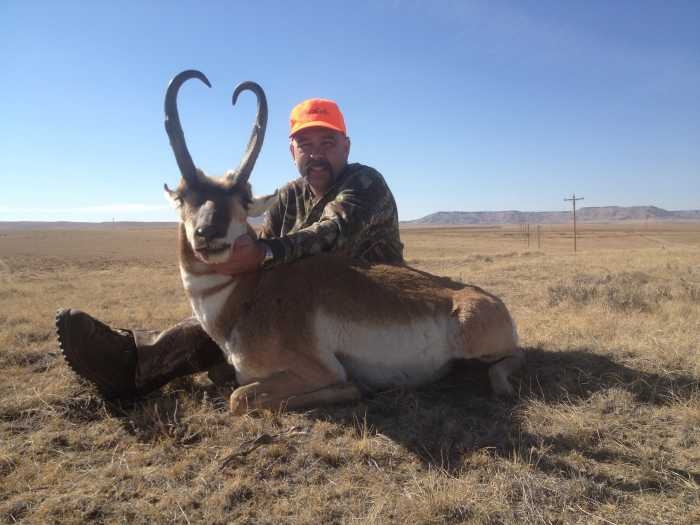Judging Trophy Antelope in Wyoming
Field Judging Antelope
Antelope are one of the most difficult animals in North America to field judge. It is important that you understand the basics of field judging before you spend the money on a guided trophy antelope hunt. One of the first questions potential clients ask is “What is the average height of the antelope Peak Adventures harvest?” What most antelope hunters don’t understand is, while height does factor into a trophy antelopes score, it isn’t the most important piece of the pie, mass is. Length is measured one time during the scoring of a trophy antelope while mass is measured four times per side. The minimum score to enter the Boone and Crocket record books is 82 inches.
To add to the difficulty of judging antelope, in most cases, you’re looking through a spotting scope at distances farther than rifle range trying to determine if a buck is Boone and Crockett material. Don’t get me wrong, when a true giant antelope is spotted, you’ll know it! In most cases it’s the bucks that are close that are the most difficult to score. You could have two bucks, within a couple of inches, standing together and most of us wouldn’t be able to tell which one is bigger.
I have grown up around antelope in Wyoming. The herd that inhabits our ranch and the properties Peak Adventures leases are considered part of the Pumpkin Buttes Herd located south of Gillette, Wyoming. This is the largest herd of antelope in the world with approximately 28,000 head roaming the Great Plains. I have the benefit of see antelope every day.
In this blog post I’m going to explain how I was taught to field judge antelope by my father and grandfather. I’m sure there are other ways to field judge a buck but this has been proven through three generations. I have taught this system to the guides at Peak Adventures and we have had consistent results by using it.
Remember; mass is the most important part of the measurement! Given that information, let’s discuss the Boone and Crockett rules to scoring an antelope.
LENGTH OF HORN: Is measured on the outside curve of the horn. The line taken will vary with different heads depending on the direction of their curvature. Measure along the center of the outer curve from tip of horn to a point in line with the lowest edge of the base, using a straight edge to establish the line end.
CIRCUMFERENCE OF BASE: Is measured at a right angle to axis of horn. Do not follow irregular edge of horn; the line of measurement must be entirely on horn material.
DIVIDE THE LENGTH: Divide the length of the longer horn by four. Starting at the base, mark both horns at these quarters (even though the other horn is shorter) and measure circumferences at these marks. If the prong interferes with the second circumference measurement go below the swelling of the prong. If the third circumference measurement falls in the swelling of the prong, move the measurement up to just above the prong. The fourth circumference measurement will always fall above the swell of the prong.
LENGTH OF PRONG: Measure from the tip of the prong along the upper edge of the outer side to the horn, then continue around the horn to a point at the rear of the horn where a straight edge across the back of both horns touches the horn, with the latter part being at the right angle to the long axis of horn.
To make the Boone and Crockett, in general, a trophy antelope buck must have seven inches of mass on the first and second circumference measurement and at least three inches at the third and fourth circumference measurement. The prong needs to be seven inches in length and the length will need to be at least fifteen inches. I have seen a couple of antelope that had an overall length of thirteen inches make the book but this is a rare exception.
FIELD JUDGING MASS: Mass is the most important measurement so the first thing I look at, if an antelope is over thirteen inches, is the relationship between the bucks eye and the base of his horn. I’ve measured many antelope over the years and an average eye width is two inches. If the eye is noticeable smaller than the base of the horn then a good rule of thumb is the buck has good horn mass at his first and second measurements.
Depending on how high the prong is in relationship will determine where the third mass measurement will come in to play. If the horn looks spindly above the prong then I’ll move on. A buck that has good mass above the prong will look like he’s shorter than he actually is. For instance, a buck measuring sixteen inches in length with good mass will look like a fifteen to fourteen in a half inch buck. This same buck with little mass above the prong may look like he’s seventeen inches. Mass or lack thereof, above the prong can create an optical illusion.
FIELD JUDGING LENGTH OF HORN: The ear on an antelope averages six inches in height. I use the ear tip to take the first measurement and make a mental mark of where the tip lands on the horn. Then I visualize taking the ear off of the antelope and place the bottom of the ear on the mark I just made. If I can get two ears on the horn then I know the antelope is at least twelve inches long. I repeat this process to finish out the measurement. It is difficult to do at first but once you’ve been around enough antelope you will start to have an eye for field measuring the height of the horn.
FIELD JUDGING THE PRONG: I use the ear method to measure the prong too. I visualize cutting the ear from the antelopes head and laying it from the back of the horn to the tip of the prong. Again, if I can lay a full ear across this length then I know it’s at least six inches long. Generally, you need at least seven inches from the prong measurement to make the book.
Make sure when judging trophy antelope you look for broken tips or prongs. Most antelope seasons, in the state of Wyoming, occur after the rut which happens in September. A half inch can make or break a buck from entering the book. Antelope are fierce competitors during the rut and will often break the tips of their horns or the prongs off.
I hope this article helps all of you. It is a good system that has worked for us over the years. It takes a while to get an eye for this system to work. Main thing is don’t get in a hurry to pull the trigger. There are a lot of antelope out there and it’s best to look at a couple or stop by a taxidermy shop before you go to the field.

